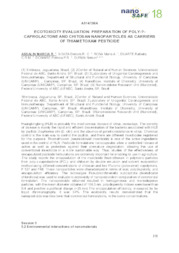Ecotoxicity evaluation: preparation of poly-E-caprolactone and chitosan nanoparticles as carriers of thiametoxam pesticide.
Ecotoxicity evaluation: preparation of poly-E-caprolactone and chitosan nanoparticles as carriers of thiametoxam pesticide.
Autoria: ASSALIN, M. R.; SOUZA, D. R. C. de; ROSA, M. A.; DUARTE, R. C. R. M.; DONAIRE, P.; DURAN, N.
Resumo: Huanglongbing (HLB) is probably the most serious disease of citrus, nowadays. The severity of disease is mainly the rapid and efficient dissemination of the bacteria associated with HLB by psyllids Diaphorina citri (D. citri) and the absence of genetic resistance in citrus. Chemical control is the main way to control the psyllids, and there are different insecticides registered for this purpose. Thiamethoxam (neonicotinoid insecticide) is one of the active ingredients used in the control of HLB. Pesticide formulations nanocapsules allow a controlled release of active as well as protection against their premature degradation, allowing the use of conventional insecticide in a more sustainable way. Thus, studies of the effectiveness of encapsulated pesticide formulations are extremely important for enabling its use in agriculture. This study reports the encapsulation of the insecticide thiamethoxam in polymeric particles from poly-?-caprolactone (PCL) and chitosan by double emulsion and solvent evaporation method using different concentrations of chitosan and two Pluronic (poloxamer) copolymers, F 127 and F68. These nanoparticles were characterized in terms of size, polydispersity, and encapsulation efficiency. The microalgae Pseudokirchneriella subcapitata (bioindicator chloroficea) was used to evaluate to ecotoxicity of nanopesticide in comparation of commercial formulation. The nanopesticide obtained resulted in homogeneous and monodisperse particles, with the mean diameter obtained of 166.3 nm, polydispersity indices were lower than 0.4 and positive superficial charge (+25 mv).The encapsulation efficiency, measured by by liquid chromatography, it was 34%. The ecotoxicity results demonstrated that the nanopesticide was less toxic that commercial formulations, in the same concentrations.
Ano de publicação: 2018
Tipo de publicação: Resumo em anais e proceedings
Unidade: Embrapa Meio Ambiente
Palavras-chave: HBL, Pesticida, Toxicologia
Observações
1 - Por padrão são exibidas publicações dos últimos 20 anos. Para encontrar publicações mais antigas, configure o filtro ano de publicação, colocando o ano a partir do qual você deseja encontrar publicações. O filtro está na coluna da esquerda na busca acima.
2 - Para ler algumas publicações da Embrapa (apenas as que estão em formato ePub), é necessário ter, no celular ou computador, um desses softwares gratuitos. Sistemas Android: Google Play Livros; IOS: iBooks; Windows e Linux: software Calibre.
Acesse outras publicações
Acesse a Base de Dados da Pesquisa Agropecuária (BDPA) para consultar o acervo completo das bibliotecas da Embrapa.

